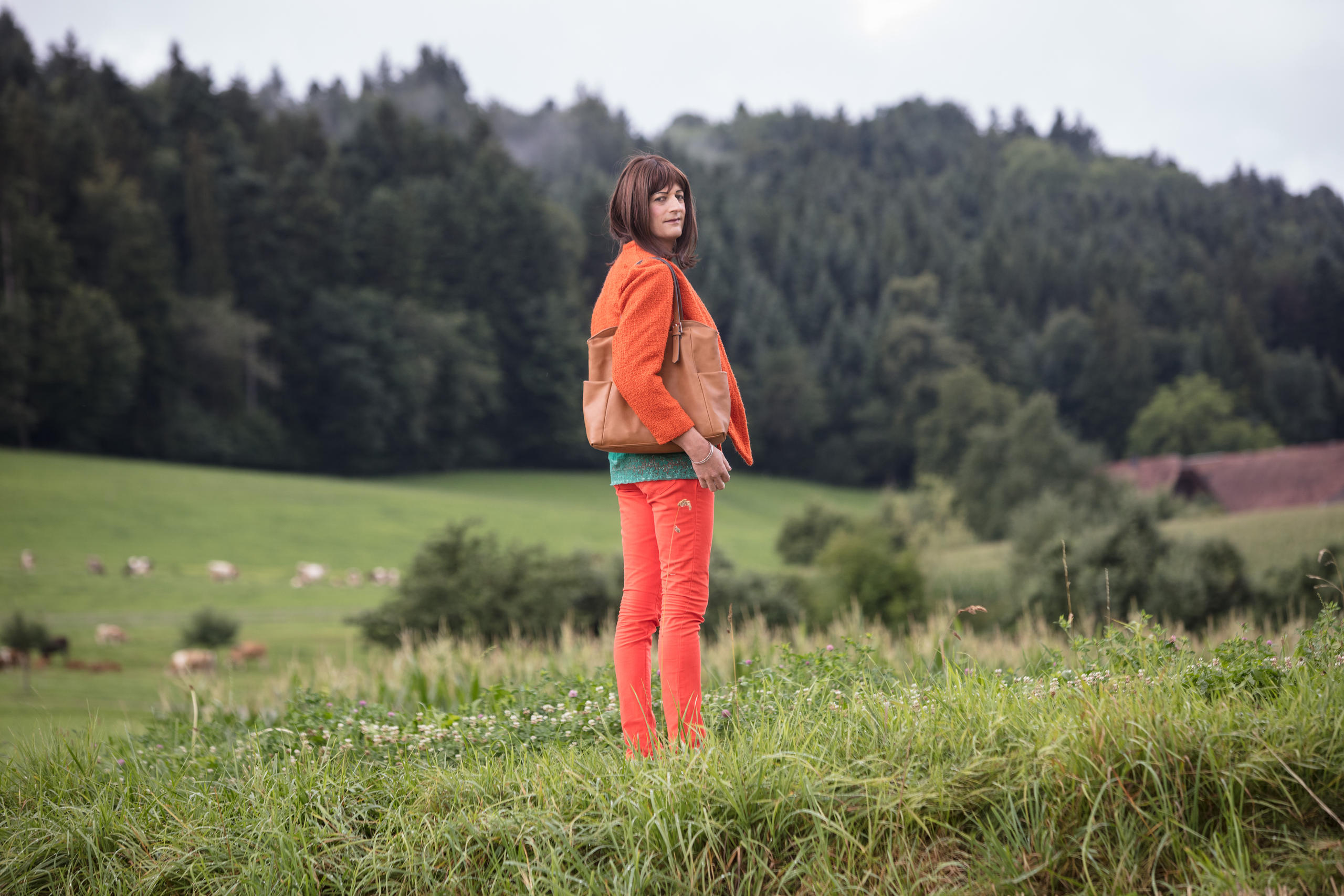
‘I did not want to die a man’

To end it all or live her identity as a woman? That was the dilemma facing Stefanie Stalder, a transgender farmer in rural Lucerne. She chose life and began the process of sexual reassignment just over a year ago. At 48, she can breathe freely again.
“Two years ago, I decided to live my true identity as a woman. The only alternative would have been suicide,” Stalder wrote to explain her story in a first e-mail exchange.
The acronym LGBTIQ is used to designate people who are lesbian, gay, bisexual, transgender, intersex and queer. With time, other terms have also appeared to define diverse sexual orientations and gender identities.
Behind these letters are life stories that are sometimes simple, sometimes torturous, but all unique.
For this reason, swissinfo.ch has decided to publish a portrait to illustrate each term which makes up the acronym. The series is part of an important and current debate in society.
The village of Grosswangen, where she lives, is reached after a drive across the Lucerne countryside, a conservative region whose narrow roads wind their way through peaceful villages. Endless fields surround the home of the 48-year-old transgender farmer, who began the transition process a year and several months ago.
She greets us in a deep and somewhat hesitant voice, backed by a look full of emotion. Dressed in orange, her slender form stands out against the green of the surrounding countryside. After hiding for four decades, Stefanie is no longer afraid to show her true identity.
“I grew up here on the family farm. I had a happy childhood until I started school.”
So as not to upset her family, she takes us to a cafe in the neighbouring village, a neutral place in which to retrace her journey. Her step seems faltering, as if she still has to get used to her new appearance. Her shy smile, however, reflects a deep sense of peace. “My inner struggle has finally ended,” she says.
“I was revolted with myself”
Stefanie began the search for her identity very young. “At school, I was supposed to act like a boy, but I could not live up to this expectation. As I didn’t correspond to either male or female models, I didn’t fit in and was bullied by the other children.”
“I was revolted with myself and felt I was becoming a zombie.”
The physical changes of puberty were unbearable to her, and she sank into depression. As the stigma of masculinity were irrevocably written on her body, suicidal thoughts appeared.
“I was revolted with myself and felt I was becoming a zombie,” she recalls. Her mother took her to see a doctor, who prescribed antidepressants but did not detect the real problem.
Exaggerated virility
As a child who loved being outdoors, Stefanie always enjoyed working on the farm.
“My brother was physically stronger, but he preferred to watch television. It’s sort of the opposite of what you would have expected.”
After a farming apprenticeship, she trained as a mason. “I thought that doing a very male job would finally quash my longing to be a woman.”
“I always fell in love quickly, in a very romantic way. It wasn’t love, though; I saw these women as an ideal.”
In 1996 she officially took over the family farm, with the dream of turning it over to organic production, although without the means to do so. To make ends meet, she took on another job in a pressed wood company.
The hard work silenced her demons, but quiet periods were torture to her. “I often got very depressed during the Christmas break.”
She threw herself into group activities, joining the yodelling club, amateur theatre, collectors of old tractors. Despite being surrounded by people and well-liked, she felt an outsider, unable to shake off the feeling of being alone.
To try and suppress her femininity, she exaggerated the masculine side, in her attitude, language and behaviour.
“Without being an alcoholic, I was a heavy drinker. I did everything to try and be a man.” Inside, however, she was slowly stifling, incapable of taking action, a spectator of her own life. She sought her likeness in passion for other women. “I always fell in love quickly, in a very romantic way. It wasn’t love, though; I saw these women as an ideal.”

Finding peace
She found fleeting moments of peace in her daily suffering by dressing as a woman.
“Since I was a child, I’d realised that I liked dressing up as a girl when I played with my brother and sisters.”
Soon, however, the game took on another dimension; when one of her sisters or her mother went out, she would sometimes slip on their clothes. Once she began to earn money, she bought women’s clothes, hid them in the barn and wore them for a few moments when no one could see.
From the barn she moved the clothes to the back of her wardrobe and sometimes slept dressed as a woman. “One day my mother saw me, but she did not say anything as she could not understand what was going on. She sometimes got rid of the clothes.”
But the urge was irresistible and Stefanie took another step, making trips to Zurich, where she walked around wearing a skirt and high-heeled shoes, protected by the anonymity of the city. “I often had panic attacks. Thinking I saw someone I knew, I would run back to my car to get changed.”
“Dying didn’t bother me, but I realised that I did not want to end my life as a man.”
Two secrets, one love
She had a long-time friend who was married to an alcoholic and violent man and whom she wanted to help. One day, she went to visit her to offer support. They started to confide in each other and a relationship of trust was born.
Stefanie revealed her secret: “I told her that I sometimes wore women’s clothes. As she grew up in Geneva, she was very open-minded about it.” Their friendship led to love, marriage and the birth of two children.
But marriage did not put an end to her identity quest. In 2007, thanks to an internet forum, Stefanie finally faced the fact: she was transgender. She sought contact with other people in the same situation, but continued to lead a man’s life for fear of losing everything.
Until, one day, there was a shoot-out at the company where she worked part-time. She lost a close friend. In shock, she began to dream that she had been killed in the attack: “Dying didn’t bother me, but I realised that I did not want to end my life as a man.”
“For the first time since I was a child, I didn’t see a stranger’s reflection. I saw myself.”
Sense of inner harmony
After many sleepless nights, tears and depression, Stefanie finally decided to start the transition process. In late March 2016, she began hormonal treatment using an estrogen gel recommended by a blogger.
“Already after one week, I felt an indescribable sense of inner harmony,” she recalls.
The next steps were removing her facial hair, changing her name and then civil status. It was a metamorphosis: “Before, whenever I took a shower, I felt I was touching a foreign body. Now it’s my body.” The sexual reassignment operation is already scheduled for November 2018. “I will have it done in Thailand, as it’s better value there,” she explains.

More
Recognising diverse sexual identities and experiences
As her story unfolds, Stefanie’s tone becomes more sure and determined: “I also plan to start speech therapy to feminize my voice.”
There is a spark in her eyes, a force capable of moving mountains. Today at the helm of an organic farm, she has won a battle against herself. However, the war is not yet won for those around her.
“In private, my parents accept my identity as a woman. However, if I met my mother on the street, she’d turn her head.” To explain her situation to the people of the village, Stefanie wrote an article in the local newspaper. “That way I have to explain myself less, although people still ask me questions.”
The children are getting used to the new situation. Stefanie is giving them time, sometimes taking off her wig at home “so they can see their father again.”
The relationship with her wife is inevitably affected by the transition. “Every step is a gain for me but a loss for her. It’s brutal,” says Stefanie. The couple must adapt, reinvent itself both on a sexual and emotional level.
“We both want to continue, but there are times when my wife says, ‘I can’t go on any more.’”
For Stefanie, however, there’s no going back, for peace has no price. “One morning, I put my wig on in front of the mirror. For the first time since I was a child, I didn’t see a stranger’s reflection. I saw myself.”
In Switzerland, “trans*” people can change their name without actually changing their sex on the official register of persons, by applying to their cantonal government. They have the right to choose the name they wish.
To change sex and be officially registered as such, they have to apply to a court. Up till a few years ago, Swiss courts required all trans* people to undergo a sex-change operation and/or furnish proof of definitive sterility. This was based on a decision of the Federal Court dating back to 1993. The situation is now evolving. In 2011 the Appeal Court of canton Zurich authorised a sex change on the registry without an operation, and the following year the Federal Registry took a similar position.
While various court systems have adjusted their rules in recent years, others continue to require evidence of an operation, definitive sterility and/or a declaration by a psychiatrist that the person is transexual. This approach is condemned by TGNS, an association that advocates for trans*External link people, and it has been dropped by countries like Italy, France and Germany.
Translated from French by Julia Bassam

In compliance with the JTI standards
More: SWI swissinfo.ch certified by the Journalism Trust Initiative






























You can find an overview of ongoing debates with our journalists here . Please join us!
If you want to start a conversation about a topic raised in this article or want to report factual errors, email us at english@swissinfo.ch.